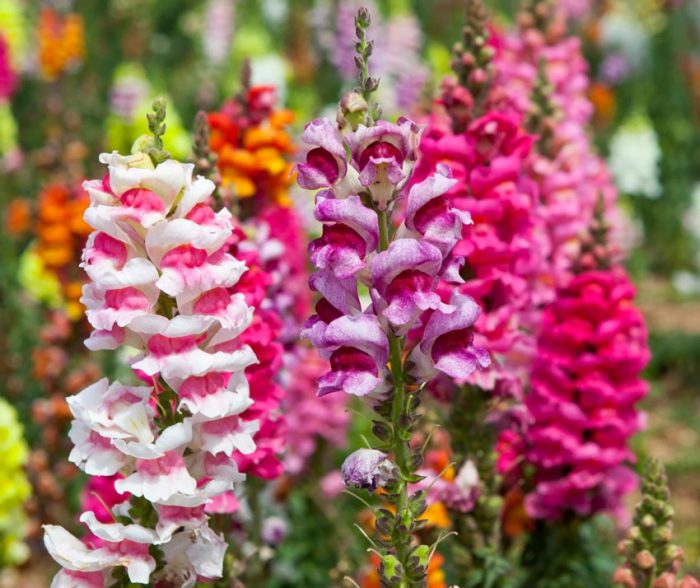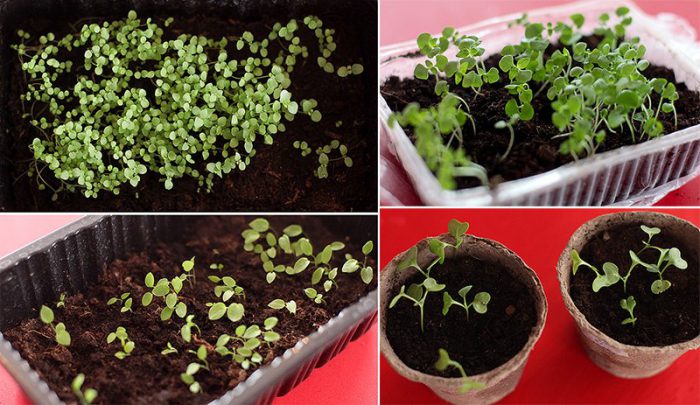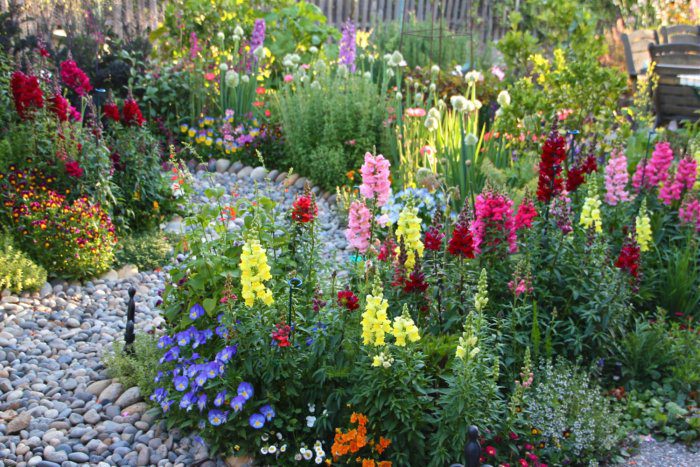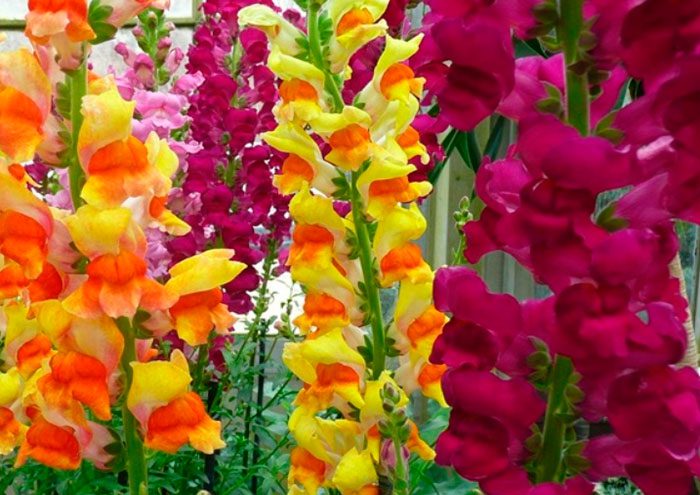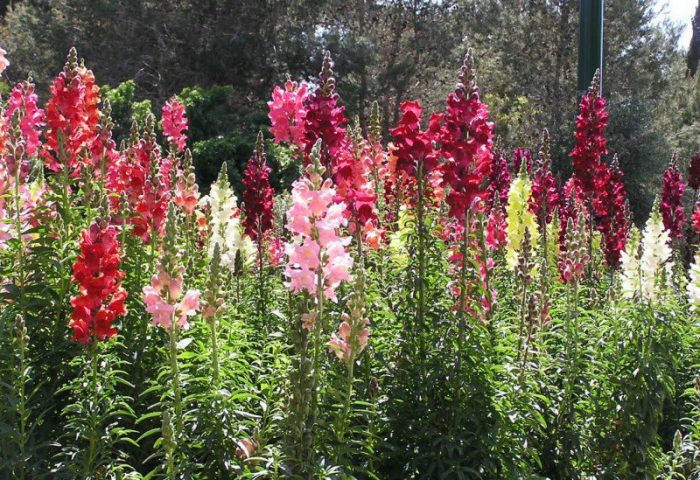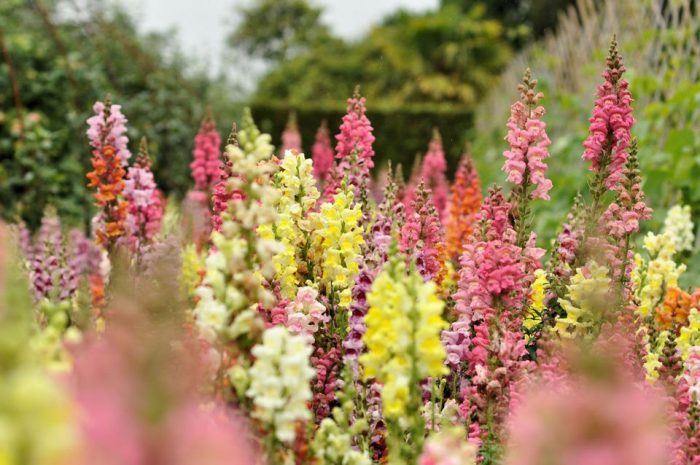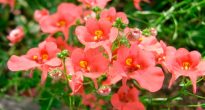Snapdragon (Antirrhinum), which is also called antirrinum, is directly related to the genus of herbaceous plants belonging to the plantain family. This genus unites about 50 species of perennial plants, including climbing plants. In the wild, these plants can be found in warm climates, and most species are found in North America. In Russia, these flowers are called "dogs", in England "snapdragon" (biting dragon), in France "wolf's mouth", and in Ukraine "mouths". "Antirrinum" in translation from Greek means "nasal", "like a nose." In the ancient Greek myth telling about Hercules, or rather, about his first feat, it is said about how he defeated the Nemean lion, the ferocity of which everyone knew. In honor of the victory, the goddess Flora was presented to Hercules with a gift - it was a lovely flower called "snapdragon". Since that time, the Greeks have developed a tradition to give the heroes a snapdragon. This plant has been cultivated for about five hundred years, and German experts took up its selection only in the 19th century. During this time, they were able to create about 1 thousand varieties of snapdragons, while it is of interest that only 1 species was used to create various varieties, namely, antirrhinum majus.
Content
Snapdragon features
This flower is represented by shrubs, as well as herbaceous plants, which have straight, finely grooved shoots, they are branched and painted in green. Their height can vary from 15 to 100 centimeters. The bushes have a pyramidal shape. Above, the leaf plates are alternately located, and below - opposite. Their shape can be lanceolate or oval-elongated, and the color varies from dark to pale green, while the veins are colored red. Fragrant flowers are relatively large, they are two-lipped and have an irregular shape. There are both double flowers and simple (depending on the variety), they are part of the inflorescences that have the shape of an ear. Their color can be yellow, pale fawn, white, pink, red (all shades), and there are also varieties with two- and three-colored flowers. The fruit is a two-celled polyspermous capsule. 1 g contains 5-8 thousand seeds. This plant begins to bloom in July, and ends after the first autumn frosts.
Often, snapdragons, which grow as a perennial in the wild, are grown by gardeners as an annual. However, if the plant is well cared for, and if conditions are favorable, the frost-resistant snapdragon can endure wintering in the open field. Moreover, next year its flowering will be more spectacular. In garden design, such a flower is grown as a curb flower, but it can decorate both a flower bed and a green lawn (if the snapdragon is planted in groups). Terraces and balconies are also decorated with such a plant. Today, ampelous varieties of such a flower are gaining more and more popularity among flower growers, for the cultivation of which you can use hanging structures, and they will also become an excellent decoration for galleries and terraces.
Growing snapdragon from seed
Sowing
Reproduction of this plant can be done by seeds, as well as vegetatively. The seeds have a good germination capacity for several years. In the event that you live in an area with a relatively mild climate, then sowing the seeds of such a flower can be done directly into open soil. The first shoots can be seen after 2.5–3 weeks, while the seedlings are not afraid of the cold snaps that occur at night. In the same places where the spring is relatively cold, it is recommended to grow this plant through seedlings. It is very easy to grow snapdragons from seeds.
Seeds are sown in the first days of March. To do this, you will need a bowl with a diameter of at least 10 centimeters, and at the bottom it should have holes for drainage. Coarse sand should be poured at the bottom, and on top of it compost soil mixed with sand. Lightly tamp and level the surface, then moisten it slightly with a spray bottle and spread the snapdragon seeds mixed with sand, sprinkle a thin layer of the same substrate on top. Water the crops with a fine spray bottle, then cover the container with clear glass. Every day, condensation must be removed from the glass surface, while airing the seedlings and, if necessary, moistening the surface of the substrate from the sprayer. If in the place where the container stands there is moderate humidity and warmth (23 degrees), then the first seedlings can be seen after half a month. After the first plants appear, the container must be transferred to a well-lit, but at the same time protected from direct sunlight, place (so that the plants do not stretch out). After the snapdragon begins to emerge en masse (after 3-4 days), the shelter must be removed for good.
Seedling
At first, the plants will grow for a long time, and during this period it is especially important to properly moisten the soil. Watering should be done in the morning so that there is enough moisture for the plants, but it would not be too much. The fact is that waterlogging can cause the development of a "black leg". If the seedling has fallen, then it should be carefully removed using tweezers, while the place where it grew should be sprinkled with crushed charcoal or used for this calcined cold river sand. After 2 real leaves are formed, it is necessary to pick the seedlings into a box or container, while they must be placed so that they are not pressed against each other. Also, for picking plants, you can use individual pots, or you can plant 3 seedlings in 1 larger pot at once. Then the plants must be placed in a well-lit, but at the same time protected from direct sunlight, place. After that, you can start hardening the seedlings. To do this, in the daytime, you need to open the window for a while, but drafts should be avoided.When a plant has 4–5 true leaves, it will need to be pinched to increase bushiness, but if the lateral shoots are growing quite quickly, then they should also be pinched.
Landing in open ground
When to plant snapdragons
The planting of the seedlings of the snapdragon should be carried out in the last days of May and the first in June. At the same time, you should not be afraid of cold snaps at night, since these plants tolerate them quite calmly. These flowers can be planted both in a sunny area and in a shaded area, but it is worth considering that it must be protected from gusts of wind, and also be well drained. A suitable substrate should be light and rich in nutrients. A mixture consisting of compost, sand, and peat, which are taken in equal proportions, is best suited for growing such a flower. The acidity of the soil should be pH 6–8.
How to plant
The distance between the bushes during planting depends on the variety of snapdragons. So, between dwarf varieties there should be a distance of 15 centimeters, between undersized varieties - about 20 centimeters, between medium-sized ones - 30 centimeters, and between tall ones - from 40 to 50 centimeters. After a bush transplanted into open ground takes root, it grows rather quickly and becomes a spectacular flowering plant. It must be remembered that it is necessary to plant seedlings in a well-watered soil in advance.
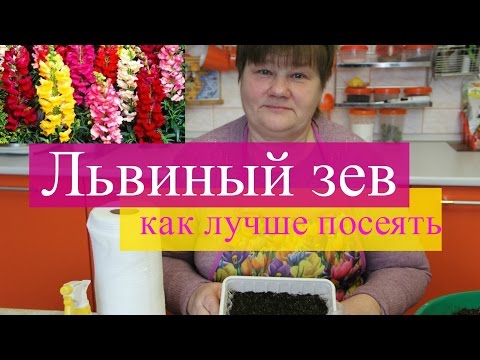

Watch this video on YouTube
Care features
Growing
Such a flower is undemanding to care for and it only needs timely watering, weeding, feeding, and it is also necessary to systematically loosen the soil surface. Watering should be done only during a drought, but remember that this procedure cannot be carried out in the evening. After watering, it will be necessary to loosen the surface of the soil and weed, this can be done on the same day or every other day. Experts advise, to make a garter of tall varieties to the support. After the flower begins to fade, it must be removed from the bush, as it takes away the strength of the plant. In order for such a plant to bloom for a long time, it should not be allowed to set seeds, and after the last flowers wither, you need to cut the flower arrow. It is necessary to cut the peduncle under the flower at the very bottom, only in this case new arrows and flowers will grow. The first time to feed the snapdragon is after it takes root after transplanting into open soil, and for this they use nitrophoska and organic fertilizers. The second time you need to feed the plant during budding, in this case, a nutrient solution is used, consisting of potassium sulfate, urea and superphosphate, and 1 large spoonful of each substance should be taken in a bucket of water.
Diseases and pests
It happens that the bushes are affected by rust, while specks of red color appear on their surface. Also, this plant is susceptible to infection with black leg, root and gray rot, septoria. Diseased plants must be destroyed as soon as possible, then it is necessary to process the soil area where they grew with a fungicidal (antifungal) agent. For snapdragons, such pests are dangerous as: fly larvae, scale insects, caterpillars, as well as butterflies that are able to lay eggs. It should be remembered that getting rid of diseases or harmful insects is much more difficult than preventing plant infection. For the purpose of prevention, it is necessary to follow all the recommendations for caring for the snapdragon, so it is necessary to timely destroy the sick and infected with harmful insects; flowers should not be planted very close to each other; it is necessary to water correctly, avoiding waterlogging of the soil; watering should be done at the root, while ensuring that water does not fall on the surface of the leaf plates.
After flowering
The flowering of such a plant can continue until the first frost in the fall. After the autumn is established, it is necessary to cut those snapdragon bushes that are cultivated as perennials very short, so that the height of the shoots is about 5-8 centimeters.Then you need to mulch the area, sprinkling it with a layer of dried foliage or sawdust mixed with peat. In the event that you have an annual snapdragon growing, then after the flowers begin to fade, you should remove them, thereby avoiding self-seeding. After all the flowers on the arrow have wither, it should be cut as short as possible. This will prevent the seeds from ripening and scattering on the soil surface. After the onset of deep autumn, it is necessary to dig up the soil where the flowers grew, and burn the remnants of the snapdragon, since harmful insects can settle on them.
How and When to Collect Snapdragon Seeds
As a rule, for most plants, seeds are harvested only after they are fully ripe. However, the collection of snapdragon seeds must be carried out in the phase of incomplete maturity. Then they are placed in a dry, well-ventilated room for maturation. Collect the seeds in a long paper bag (as for a baguette). It is necessary to start collecting seeds only after the fruits located at the bottom of the peduncle are fully ripe. To do this, the top of the peduncle, on which there are still green fruits, must be cut off and thrown away. On the part of the flower arrow that remains, you need to put on a bag of paper, tied with a thread below the fruit. Then it remains only to cut the stem below the dressing site. Then the inverted bag must be hung in a dry and warm place and you just have to wait for the ripe seeds to spill out into the bag by themselves. Ripe seeds should be poured into a small cardboard box and stored in a dry place where the air temperature will be from 3 to 5 degrees. In this case, the boxes must be protected from water ingress.
Main types and varieties
Today, experts have several classifications of this plant according to various characteristics. The most popular classification is by the height of the bush. By the size of the bush, snapdragon varieties are divided into 5 groups:
- Gigantic - the height of the bush is 90-130 centimeters. In this plant, the stem, located in the center, is much higher than the second-order stems, while there are no third-order stems. Popular varieties: "Arthur" - bush height from 90 to 95 centimeters, cherry flowers; "F1 red XL" and "F1 pink XL" - the bush reaches 1.1 meters, the flowers are red and pink (respectively).
- High - the height of the bush is 60–90 centimeters. They are cultivated for cutting, and also as a vertical accent in groups or in mixborders. The central stem is much higher than the lateral ones. When cut, the flowers of this plant can stand for about 7 days or even longer. The most fragrant varieties are those whose flowers are colored in various shades of yellow. Popular varieties: "Anna German" - flowers are painted in light pink; "Canary" - flowers of a rich yellow color; a mixture of varieties "Madame Butterfly" - double flowers can be painted in a variety of colors.
- Medium (semi-tall) - a bush with a height of 40 to 60 centimeters. The varieties are versatile, they are cultivated both for cutting and as flower bed decoration. They are distinguished by strong branching. The central stem is slightly higher in height than the lateral ones. Popular varieties: "Golden Monarch" - has a yellow color; "Ruby" - deep pink flowers; "Lipstick Silver" - painted in whitish-pink color.
- Low - the height of the bush is 25–40 centimeters. They are cultivated as border or flower bed plants. These varieties have a large number of flowering stems of the second and third order, while the central stem has the same height as the stems of the first order or slightly below them. Popular varieties: "Tip-top", "Hobbit", ampel hybrid plant "Lampion".
- Dwarf - the height of the bush varies from 15 to 20 centimeters. The varieties are intended for carpet flower beds, ridges, borders, rock gardens. They are also grown as a potted flower.There is strong branching up to stems of the third and fourth order, while the central stem is lower or has the same height as stems of the second order. Popular varieties: "Sakura Blossom" - there is a speck on whitish-pink flowers; "Candy Showers" is an ampelous variety.
There is also a very popular classification of the Snapdragon of Sanderson and Martin for year-round cut varieties. However, this classification is of interest only to those growers who grow snapdragons for sale.

